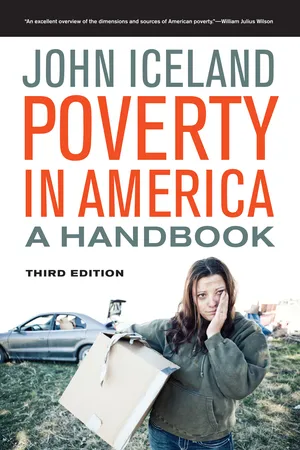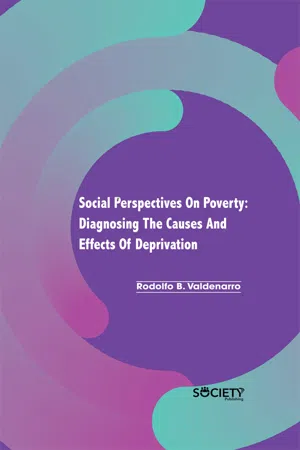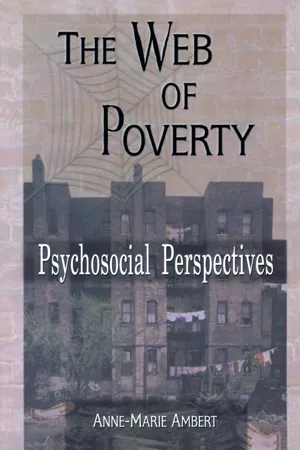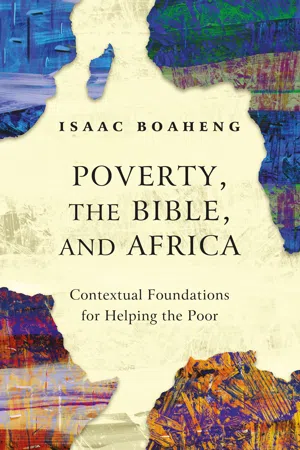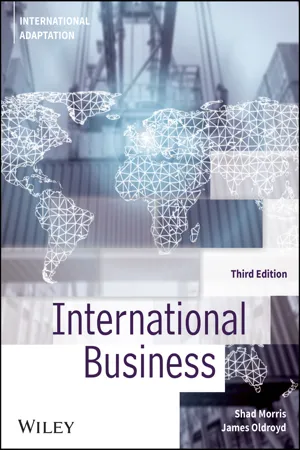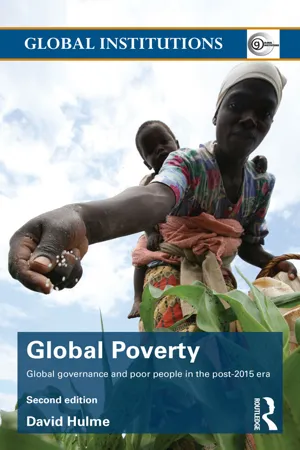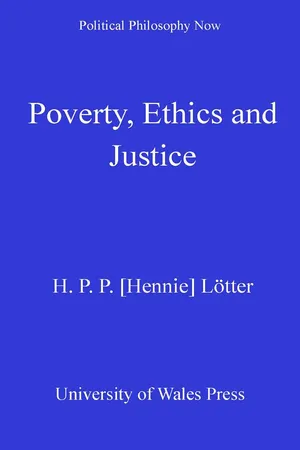Social Sciences
Causes of Poverty
The causes of poverty are multifaceted and can include factors such as lack of access to education, healthcare, and employment opportunities, as well as systemic issues like discrimination and unequal distribution of resources. Additionally, economic factors such as low wages, high cost of living, and economic downturns can contribute to poverty. These causes often intersect and compound each other, leading to complex and entrenched poverty situations.
Written by Perlego with AI-assistance
Related key terms
1 of 5
10 Key excerpts on "Causes of Poverty"
- Elizabeth Segal, Karen Gerdes, Sue Steiner, , Elizabeth Segal, Karen Gerdes, Sue Steiner(Authors)
- 2018(Publication Date)
- Cengage Learning EMEA(Publisher)
The Causes of Poverty LO 2 Addressing the problem of poverty would be easier if there were consensus about the Causes of Poverty. There appears to be no single cause, but rather, numerous perspectives. Some theories focus on the individual, and others look at structural reasons for poverty. Many of the theories are controversial and contradictory. EP 2 Table 3.3 Average Percentages of Persons in Poverty Decade Children All Persons 1960s 20.84% 17.47% 1970s 15.69% 11.81% 1980s 20.46% 13.84% 1990s 20.62% 13.75% 2000s 17.6% 12.5% 2010s 21.1% 14.7% Sources: Dalaker & Naifeh (1998); Proctor, Semega, & Kollar (2016). Copyright 2019 Cengage Learning. All Rights Reserved. May not be copied, scanned, or duplicated, in whole or in part. Due to electronic rights, some third party content may be suppressed from the eBook and/or eChapter(s). Editorial review has deemed that any suppressed content does not materially affect the overall learning experience. Cengage Learning reserves the right to remove additional content at any time if subsequent rights restrictions require it. 76 CHAPTER 3 For example, one long-standing belief called the culture of poverty con-tends that people learn to be poor from growing up in impoverished areas. Although the environment is certainly powerful, this theory does not explain how some people who grow up poor become economically self-sufficient. An-other theory cites the functionality of poverty, indicating that poverty plays an important role in the economic structure and that there is little incentive to rid the nation of it. According to this theory, maintaining a pool of peo-ple who are poor means that workers are always available for less desirable and lower-paying but necessary jobs. This theory maintains that poverty keeps wages from increasing too much too fast. Most views are also laden with val-ues about worthiness and deservedness.- eBook - PDF
Poverty in America
A Handbook
- John Iceland(Author)
- 2013(Publication Date)
- University of California Press(Publisher)
79 chapter 5 Causes of Poverty It is commonly believed that individual failings or wayward values propel people into poverty. In the 1960s, anthropologist Oscar Lewis wrote, “By the time slum children are age six or seven they have usually absorbed the basic values and attitudes of their subculture and are not psychologically geared to take full advantage of changing conditions or increased opportunities which may occur in their lifetime.” 1 When asked about Causes of Poverty, about half of Americans say that poverty is the fault of individuals, while nearly the same proportion feel that circumstances play the principal role. Affluent people are more likely to believe that poor people are not doing enough to help themselves, while the poor are more likely to point to circumstances. About two-thirds of Americans believe that the poor have the same values as other Americans, and about a fifth think they have lower moral values. 2 Economists often focus on individual traits by emphasizing the role of human capital in people’s economic well-being. Human capital refers to people’s knowledge, skills, personality, and experiences that help them do a job well. Many studies have indeed shown that people who invest in their education and skills can expect higher incomes. However, this emphasis on individual characteristics as the main determinant of poverty often overlooks the roles that social, economic, and political systems play in affecting people’s well-being. 3 In this chapter I discuss the underlying structural cause of poverty, including why poverty is more prevalent among some groups than others. I begin with a brief 80 | Causes of Poverty discussion of general sociological theories of social stratification. I then examine the role of the economy and low-wage work in explaining pat-terns of poverty, analyze changing patterns of racial and ethnic stratifi-cation, and, finally, discuss gender norms, family structure, and culture and their impact on poverty. - Rodolfo B. Valdenarro(Author)
- 2020(Publication Date)
- Society Publishing(Publisher)
This chapter provides highlights on the causes of the poverty such as lack of income and assets, the basics of poverty like voicelessness and powerlessness, and vulnerability. This chapter also mentions the cultural cause of the poverty and the lie of worthlessness that is being caused by the poverty. This chapter addresses how to find out the solutions or how to untangle the Causes of Poverty. This chapter is consisting of the effects that are produced by the poverty such as feminist perspective on poverty, minimum calories consumptions, minimum consumption expenditure, the approach of government with respect to the curb poverty, and vicious circle of poverty. 3.1. INTRODUCTION Poverty refers to a state in which one lacks a usual or socially acceptable amount of money or material possessions. In phase of poverty, people lack the key resources which is essential in satisfying one’s needs and wants. In this context, the identification of poor people first requires a determination of the various key factors and elements that constitutes basic needs. These may be defined as narrowly as “those which is essential for survival” or as broadly as “those reflecting the prevailing standard of living in the community.” The first criteria take into consideration those people who are near the borderline of starvation or death from exposure; the second would extend to people whose basic amenities such as nutrition, clothing, and housing, though adequate to preserve life, do not measure up to those of the population as a whole. The problem of definition is further complicated by the noneconomic connotations that the word poverty has acquired. Poverty has been associated, for example, with poor health conditions, poor quality of education or skills, an unwillingness or inability to work, high rates of disorderly or disruptive behavior, and improvidence.- eBook - PDF
- Shad Morris, James Oldroyd(Authors)
- 2020(Publication Date)
- Wiley(Publisher)
What we do know is that poverty is usually the poverty a general scarcity or lack of material possessions or money for consumption; a persis- tent lack of income that deprives an individual of the ability to obtain appropriate levels of food, water, clothing, shelter, health care, and/or education 176 CHAPTER 10 Poverty convergence of multiple social factors beyond the reach of individuals, and of multiple individual factors beyond the reach of governments. In the developing world, many social factors can contribute to poverty, including limited access to credit and capital markets, extreme environ- mental degradation, lack of public health care, poor infrastructure, and war. 5 For example, the coronavirus (COVID-19) crisis of 2020 pushed nearly 50 million people into extreme poverty. These new poor were mostly found in rural areas of countries with limited access to health ser- vices, insurance, banking services and where the people are often dependent on family mem- bers in urban areas to send money home. One study showed that families in rural villages in China experienced losses averaging $282–$704 per month after the crisis. Villagers reduced their spending on food as a result, with signifant consequences for nutrition and long-term human capital development. 6 The Poverty Trap What is most notable, however, is that the poor generally also have a much lower level of individual capability—for health, education, nutrition, and hope. Increased personal ability can be a way out of poverty; without it, the poor are often considered to be “trapped” in poverty or in a poverty trap. As Nobel Prize–winning economist Amartya Sen points out, poverty deprives individuals of key capabilities, limiting their ability to achieve and earn, thus keep- ing them poor and limiting their opportunities to increase their capability. - eBook - ePub
The Web of Poverty
Psychosocial Perspectives
- Terry S Trepper, Anne Marie Ambert(Authors)
- 2014(Publication Date)
- Routledge(Publisher)
Chapter 2 Systemic Causes of PovertyThere are multiple Causes of Poverty and none can explain independently all the individual situations of economic disadvantage; causes tend to cluster and to reinforce each other. They can be divided into two types: systemic and personal. Systemic refers to social and economic variables, such as overall changes in the structure of the economy. Personal refers to attributes of the poor. As a general rule, personal causes are preceded by systemic causes; systemic phenomena generate both poverty and the personal sources of poverty (Haveman and Wolfe, 1994). Were the economic and social Causes of Poverty eliminated, the personal causes, while not vanishing entirely, would be radically reduced.The systemic causes examined in this chapter are tied to the globalization of the economy, the evolving structure of the North American economy, unemployment and underemployment, the heavy national debt, inadequate social assistance payments, and more recently but as a lesser cause, low-skilled immigration. The key systemic variables of racial segregation and discrimination are discussed in Chapter 8 .Globalization of the EconomyThe 1970s witnessed the slow emergence of the economic movements which culminated in the transformation of world policies in the early 1990s, beginning with the GATT signed by 111 countries in 1993. Various free trade agreements ensued between Canada and the United States, and at an even more international level, between several Western European countries, to form a unified common market,1 with a sole currency as one of its goals.2 There has initially been some resistance to the terms of the free trade agreements on the part of some nations: by European countries such as Denmark, Portugal, and Spain; and in North America, by Canada. These countries face, at least in the short run, a far greater potential for the dislocation of their economies than do their more powerful neighbors such as France or Germany and, on this side of the Atlantic, the United States. In Canada, many manufacturing jobs were and are being lost to the United States and, with NAFTA - eBook - ePub
Poverty, the Bible, and Africa
Contextual Foundations for Helping the Poor
- Isaac Boaheng(Author)
- 2020(Publication Date)
- HippoBooks(Publisher)
[13]The Social Exclusion Approach
The social exclusion approach is the third perspective on understanding poverty. The social exclusion that poverty brings may be in the form of “either economic dimension (exclusion from the labor market opportunities to earn income) or a purely social dimension (exclusion from decision-making, social services, and access to community and family support).”[14] This approach to poverty emerged in France in the 1970s and 1980s as a means of explaining the precarious situation of the disadvantaged and marginalized due to their inability to take part in the major economic, political, and social enterprises.[15] The meaning of the expression “social exclusion” has metamorphosed over the years.[16] In the 1970s many people became unemployed due to decline in business activities. In such a context, the term exclusion was used to denote the process that led to the expulsion of people from the job market. In the 1990s, prevalent human rights issues led to defining “excludees” as those who are “partly or completely outside the effective scope of human rights.”[17]The social exclusion approach differs from the economic and capability deprivation approaches in that the latter focus on individual characteristics and circumstances while the former shifts attention to the relational quality of life (its social dimension). According to the exclusion approach, one may have high income and still be poor if there is lack of social order and hence, insecurity in the community. Moreover, the analysis of exclusion involves the study of societal structure and the conditions of the marginalized groups, such as minority groups and the landless. Social exclusion therefore involves cultural, institutional and social dimensions, which are absent in the first two approaches. It advocates for the need to redistribute opportunities and resources in order to improve the lives of the marginalized. - Shad Morris, James Oldroyd(Authors)
- 2023(Publication Date)
- Wiley(Publisher)
In the developing world, many social factors can contribute to poverty, including limited access to credit and capital markets, extreme environmental degradation, lack of public health care, poor infrastructure, and war. 5 For example, the coronavirus (COVID-19) crisis forced nearly 50 million people into extreme poverty, most of whom were found in rural areas of countries with limited access to health services, insurance, banking services and in places where people often depend on family members in urban areas to send money home. One study showed that families in rural villages in China experienced losses averaging $282–704 per month after the crisis. Villagers reduced their spending on food as a result, which had a significant impact on nutrition and long-term human development. 6 The Poverty Trap Most notable is that the poor generally have fewer resources—for health, education, nutrition, and hope. Increased resources can be a way out of poverty; without it, the poor are often con- sidered to be “trapped” in poverty or in a poverty trap. As Nobel Prize–winning economist poverty trap an economic condition in which it is difficult for an individual to obtain enough capital and/or credit to escape poverty; it causes poverty to persist and is also called the “cycle of poverty” Chip Somodevilla/Getty Images FIGURE 10.2 Poverty in South Africa The poor in South Africa live in overcrowded conditions which often lack basic standards of hygiene and can become breading grounds for disease. 10.1 Causes and Consequences of Global Poverty 213 Amartya Sen points out, poverty deprives individuals of key capabilities, limiting their ability to achieve and earn, thus keeping them poor and limiting their opportunities to increase their capability. For the very poor, the rate of return from investing in food, education, or a business is so low that, given their resources, they cannot improve their circumstances. As a result, they remain poor and trapped in poverty.- eBook - ePub
Global Poverty
Global governance and poor people in the Post-2015 Era
- David Hulme(Author)
- 2015(Publication Date)
- Taylor & Francis(Publisher)
2 Understanding and explaining global poverty • Understanding poverty: conceptual building blocks • Conceptualizing global poverty • The causes of global poverty • Why poverty occurs: the polemics • Global poverty: complex issues need complex analyses • ConclusionWhen I give food to the poor, they call me a saint. When I ask why the poor have no food, they call me a Communist. (Hélder Câmara, Former Archbishop of Olinda and Recife, Brazil)The same goes for attempts to look at countries that have done badly (the “bottom billion”) and divine the causes of failure. These attempts are much like trying to figure out the common characteristics of people who bet on the zero just before it came up on a roulette wheel; they do little but disguise our fundamental ignorance.(Angus Deaton, 2013)1Ideas matter, they can change the attitudes and behaviors of individuals and shape the practices of institutions, transform the social norms of entire societies. In this chapter the many ideas that have fed into the understanding of global poverty, and helped or hindered its progress on the international agenda, are examined. The concept of global poverty, and its increasing association with sustainable development, has not evolved in a vacuum or in some form of global academic seminar room. It is a product that is intimately related to structures of power and overt and covert processes of political contestation. Those controlling substantial material capabilities (countries, banks, corporations, social classes, political and economic leaders, and philanthropists) and influencing powerful institutions are much more likely to shape the evolution of ideas than those without such power. They may do this directly, by pushing for public acceptance of ideas and interpretations of ideas that serve their interests, or indirectly by resourcing and promoting individuals, think tanks, media and universities that are aligned to the ideas and forms of analysis that they favor. The best ideas are not always the ones that dominate theory and practice: at times, as Paul Krugman has observed, “bad ideas flourish because they are in the interests of powerful people.”2 - eBook - PDF
- Hennie Lötter(Author)
- 2011(Publication Date)
- University of Wales Press(Publisher)
2 • Defining Poverty as Distinctively Human 1 There are lots of things one can say about poverty without fear of contradiction. Poverty is arguably the biggest problem facing humans today 2 and the greatest cause of suffering on earth. 3 Poverty is responsible for more preventable deaths than anything else. 4 We, human beings on earth, have all the knowledge and resources available we need to eradicate poverty everywhere. 5 Never before has poverty been so high on the agenda of so many governments and international bodies. The world has never before witnessed so many heads of state and governments publicly commit themselves to eradicate poverty. 6 Despite all this, poverty still persists as a massive problem affecting hundreds of millions of human beings across the globe. 7 Most of us can identify human beings suffering from poverty easily, but find it slightly more difficult to understand poverty properly. Note the following remarks by a poor Kenyan man about the visibility of his poverty: Don’t ask me what poverty is because you have met it outside my house. Look at the house and count the number of holes. Look at my utensils and the clothes that I am wearing. Look at everything and write what you see. What you see is poverty. (quoted in Narayan et al., 2000a: 30) In this respect poverty resembles the common cold. Most humans can easily and accurately observe when a fellow human suffers from the common cold, as the symptoms are clearly visible and identifiable. A further resem-blance between poverty and the common cold that will emerge later on is that both phenomena can be caused by a variety of factors. As the common cold is caused by a virus that constantly mutates so poverty results from one or more causes drawn from a wide-ranging set of factors. In this chapter I aim to deepen our understanding of poverty by interpret-ing the conventional definitions of poverty in a new light. - eBook - PDF
- Craig Calhoun, Chris Rojek, Bryan S Turner, Craig Calhoun, Chris Rojek, Bryan S Turner(Authors)
- 2005(Publication Date)
- SAGE Publications Ltd(Publisher)
There are major challenges to both these research traditions. Researchers who wish to conduct robust research and assessment of poverty over time or across place must come up with viable measurements that really get at what we mean by the term ‘poverty’ in diverse settings. Researchers who wish to investigate claims about the impact of household (or com-munity) poverty on the outcomes of children or adults must grapple with issues of selection bias if they are going to be taken seriously in the scientific and public debates around this important issue. Whether it be through natural experiments, instrumental variables, family and community fixed effects models, or some other innovative statistical approach, researchers who wish to make claims about the effects of poverty must go beyond traditional regression models to have their claims taken seriously in a social and political environ-ment where it is presumed that the poor – and not poverty – are responsible for their own reproduction. This chapter has not done justice to wide swathes of the sociological research tradition on poverty. I have also not reviewed the illus-trious tradition of community, ethnographic studies of the poor, extending all the way back to the Chicago School of the early twentieth century onward through global ethnographies of the twenty-first. This kind of qualitative research does much of the legwork in generat-ing the casual stories to undergird the statisti-cal associations that the quantitative poverty researchers document. These two intellectual traditions must be in constant dialogue – each moving toward the other – in order to solid-ify the foundation of our knowledge about economic inequality and deprivation in rich countries. NOTES 1 For the text of the speech see Harpers (August 1990), p. 22. 2 Such a conception fits very well with Karl Marx’s notion of the physical reproduction of labor.
Index pages curate the most relevant extracts from our library of academic textbooks. They’ve been created using an in-house natural language model (NLM), each adding context and meaning to key research topics.

